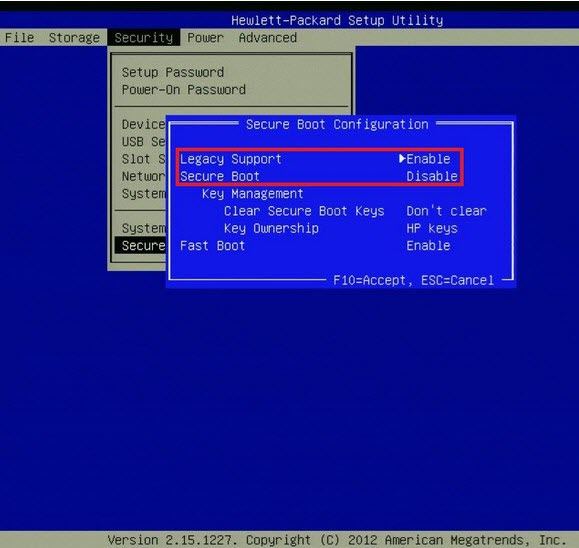

- #Enable quickboot drivers#
- #Enable quickboot update#
- #Enable quickboot Patch#
- #Enable quickboot full#
- #Enable quickboot windows 8#
#Enable quickboot drivers#
Windows does this by saving an image of the Windows kernel and loaded drivers to the hiberfile (C:\hiberfil.sys) upon shutdown so when you start your PC again, Windows simply loads the hiberfile (C:\hiberfil.sys) into memory to resume your PC instead of restarting it.įor more information about fast startup, see:
#Enable quickboot update#
Also, the HTML5 vSphere Update Manager functionality included with this release definitely helps to close the gap on things that were missing from the previous HTML5 experience prior to vSphere 6.7.How to Turn On or Off Fast Startup in Windows 10įast startup (aka: hiberboot, hybrid boot, or hybrid shutdown) is turned on by default in Windows and is a setting that helps your PC start up faster after shutdown.
#Enable quickboot Patch#
The new Quick Boot feature will greatly reduce the time it takes to patch and upgrade hosts. There is just so much new functionality and features that allow administrators to be more effective and efficient in carrying out tasks in their vSphere environments. The more I dive into this release, the more excited I become. HTML5 Update Manager Home in vSphere 6.7 VCSA TakeawaysĬonfiguring VMware ESXi 6.7 Quick Boot and HTML5 vSphere Update Manager VUM are great new features found in vSphere 6.7. Note the Baselines, Updates, and ESXi Images tabs. Viewing compliance scan results in HTML5 VUM in vSphere 6.7Īfter navigating to the Update Manager Home location. A point to note also, you have the link Go to Update Manager Home button that takes you to the Update Manager Home location where you can add images, etc. Notice I now have patches displaying that can be remediated. I added in an ESXi 6.5 host into the infrastructure, attached the baselines, and ran the Check Compliance operation. Switched gears below since there are no patches as of yet for ESXi 6.7. Checking compliance based on host baseline HTML5 ESXi 6.7 Attaching a host baseline in ESXi 6.7 vSphere Update Manager VMware vSphere 6.7 VUM HTML5 clientĪttaching the default Non-Critical Host Patches and the Critical Host Patches to an ESXi 6.7 host. Notice the familiar actions however with the Attach button ready to attach an updates baseline.

Below, clicking on a host then clicking the Updates tab. Navigating the new HTML5 vSphere Update Manager functionality. VMware’s description of the Quick Boot functionality if you hover over the information VMware description of the Quick Boot process in ESXi 6.7 ESXi 6.7 Quick Boot Configuration enabled What was interesting, my nested ESXi host has this checked by default. Quick Boot Settings are found under the Host Cluster Settings configurationĪs you can see the Quick Boot functionality comes down to a simple checkbox. Information regarding the script is found at:Īs you can see below, the script quickly points out that my Nested ESXi 6.7 installation is not compatible with Quick Boot. VMware has made a handy little script that is built into ESX 6.7 that allows testing the hardware compatibility with ESXi Quick Boot. The big names such as Dell and HP are already on board. The vendor specific hardware must be compatible with this new functionality. The Quick Boot functionality relies on integration and compatibility with OEM hardware vendors. Configuring VMware ESXi 6.7 Quick Boot and HTML5 vSphere Update Manager VUMĪ note about Quick Boot. Even if your hardware is compatible with the new Quick Boot, if you are running a legacy version of ESXi, this won’t be available. A note here before getting excited about potential backwards compatibility, this functionality is only available for hosts that are running ESXi 6.7. This functionality is utilized with vSphere Update Manager so that patching and upgrades are completed much more quickly.
#Enable quickboot full#
What is the Quick Boot functionality? Quick Boot functionality allows restarting only the hypervisor instead of going through a full reboot of the host hardware including POSTing, etc. Let’s take a look at Configuring VMware ESXi 6.7 Quick Boot and HTML5 vSphere Update Manager VUM functionality. There are still things you can’t do in the HTML5 client such as configuring the ESXi quick boot functionality, but the basic VUM functionality is there now. The vSphere Update Manager functionality is now in HTML5 trim. VMware has certainly made tremendous progress in getting the functionality not only ported over but also new and improved workflows in place with the HTML5 client. We are all no doubt excited about the progress being made with the HTML5 client in the latest vSphere 6.7 release.


 0 kommentar(er)
0 kommentar(er)
